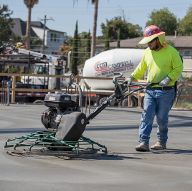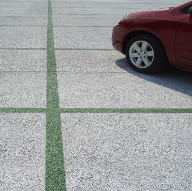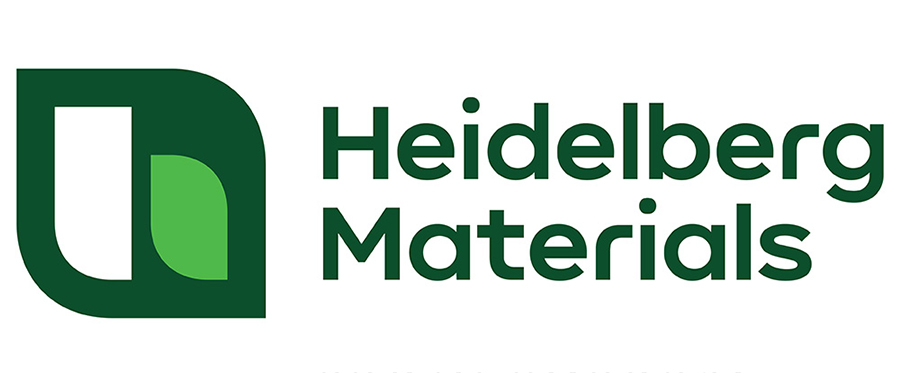
Intended use and desired appearance determine the best finish for concrete. Broomed or troweled finishes are often specified. Colors, textures and exposed aggregate are decorative options.
Color and Texture: Lehigh Hanson produces concrete in a variety of colors by mixing in pigments, which become an integral part of the mix.
Color can vary slightly from load to load. Preparation and additional steps can improve consistency:
• If a higher slump is required, use a superplasticizer.
• Take special care when adding water to the mix.
• Plan for where one load ends and another begins to minimize color discrepancy.
• Use only non-chloride
accelerators; calcium chloride can dramatically change the color of concrete.
• Cure colored concrete for 3 to 7 days. The age and temperature of the concrete when it is poured will affect the color, as will the type and consistency of subgrades
and forms.
• Apply sealers to prevent mottling once the concrete has matured and the internal moisture content is reduced.
Patterns and Textures: Concrete can be pattern-stamped with special tools to create the look
and feel of slate, cobblestone, brick, tile and many other textures. An exposed aggregate finish gives traditional concrete a more natural look. Exposed aggregate is achieved by washing away the surface mortar just as the concrete hardens.
Concrete Sealers: After concrete is fully cured, the application of a concrete sealer has a number of benefits:
• Provides protection against de-icing salts.
• Resists mildew and surface staining.
• Improves
appearance.
• Makes surfaces easier to clean.
• Inhibits efflorescence (a whitish powder on the surface).
Due to the porous finish of exposed aggregate concrete, a surface sealer is highly recommended.

Curing concrete is critical to strength gain and long-term durability. The key is keeping it as moist as possible for the first seven days after placement. In addition, it must be allowed sufficient drying time before being subjected to freezing temperatures or to de-icing salts.
Curing concrete properly requires the correct control of moisture and temperature. Without proper curing, concrete may only achieve 50% of its potential design strength. The wisdom of a seven-day curing period rests on two facts:
• Cement,
the active ingredient in concrete, requires constant moisture to gain strength.
• If the concrete is kept moist for the seven-day period, it will not only gain strength, but will also shrink less and produce fewer cracks.
Curing can be assisted in a number of ways:
• Water ponding or spraying a mist over the concrete.
• Coverings such as wet burlap, polyethylene, insulating blankets, or similar materials.
• Leaving the forms
in place.
A liquid curing agent is the most effective and convenient method. The curing agent should be applied as soon as finishing is complete. Curing agents form a membrane on the surface of the concrete in order to retain moisture.
Once the curing agent has been applied, no further working of the concrete can be done. A spray or roller is used to apply curing agents.
U.S. and Canadian standards specify minimum temperatures, moisture levels and length of time
for proper curing.
Cold Weather Curing: Concrete can be placed safely throughout the colder months if precautions are taken. During colder weather, the mix should be adapted to the ambient temperature by heating the concrete, adding accelerators and providing
protection.
Concrete generates heat during hydration, the chemical process by which cement reacts with water to form a hard stable paste. Factors affecting hydration include initial concrete temperature, ambient air temperature, the dimensions
of the concrete, and mix design. The temperature of the concrete during and after placement is critical since concrete sets more slowly as the temperature drops. Finishing and form removal may be delayed in cool weather. Suitable precautions should
be taken to maintain strength development.
Do not place concrete on frozen ground, on snow, or in freezing weather. If concrete freezes while in a saturated condition, surface problems like scaling, spalling or cracking can arise due
to the expansion and contraction of frozen water inside the concrete. During freezing weather, water curing of concrete should be terminated 12 hours before the end of the protection period. Do not use a curing agent if there is any chance that
the concrete will freeze during the curing period.
• Protect concrete from freezing temperatures for 3 to 7 days after placing.
• Leave forms in place as long as possible. Corners and edges are most vulnerable (cover
and heat if necessary).
• Protect flatwork by covering and heating, or cover with insulated blankets with plastic and straw.

Concrete is one of the most durable building materials available to the construction industry, but it can be tarnished by other materials. Over the years, Lehigh Hanson compiled a list of common cleaning challenges and how to solve them.
Beverages: Coffee, tea, alcoholic beverages and soft drink stains can normally be removed with soap and hot water. But if stains persist, apply a bandage saturated with 1 part glycerol (glycerin) diluted with 4 parts water. Two parts of
isopropyl alcohol may be added to this mixture to speed up the removal action. The bleaches described for removal of smoke stains are also effective in removing stubborn coffee and other stains. A poultice of talc and trichloroethylene can
be used on tough stains.
Dirt: Airborne dirt can collect on any concrete surface to form a dark and sometimes oily buildup or stain. Buildings with architectural concrete may need to be cleaned of air pollution deposits
to regain their original appearance. Some dirt can be removed by scrubbing with detergent and water or 1 part hydrochloric acid in about 20 parts water. However, special proprietary cleaners are often preferred over hydrochloric acid solutions
that attack concrete.
A solution of 1 part phosphoric acid to about 3 parts water can be used to scrub away light to moderate amounts of dirt with little to no corrosion. Proprietary cleaners, made with hydrochloric acid and buffers
to protect the concrete, are used to remove severe dirt buildup. An alkaline pre-wash followed by an acetic acid wash is another cleaning method. Special cleaning solutions can be specially designed to remove particular types of dirt.
The methods used to remove oil can be helpful in removing very oily dirt. Steam cleaning and light sandblasting or water blasting are also effective.
Once a surface is clean, it is good practice to apply a breathable clear sealer
(such as a methacrylate or acrylic-based material) or a clear water-repellent penetrating sealer (such as silane or siloxane) to resist dirt build-up and make future cleaning easier. Some cleaning specialists prefer the silane or siloxane
treatments for their high breathability (often with a 95% vapor transmission).
Epoxies: Most solidified epoxies can be removed from small areas by burning them off with a blowtorch. Adequate ventilation must be provided since
black acrid smoke will be given off. If a black stain remains, it can be treated like smoke stains. Abrasive blasting is more appropriate for large areas.
Grease: Grease does not penetrate concrete, so scraping and scrubbing
will usually remove it.
Scrape off all excess grease from the surface and scrub with scouring powder, trisodium phosphate or detergent. If staining persists, methods involving solvents are required.
Use refined naptha
solvent (mineral spirits) or a chlorinated-hydrocarbon solvent such as trichloroethylene* to make a stiff poultice. Apply to the stain and do not remove until the paste is thoroughly dry. Repeat the application as often as
necessary. If required, scrub with strong soap, scouring powder, trisodium phosphate or proprietary cleaners specially formulated for removing grease on concrete. Rinse with clear water.
For large areas, such as an entire floor,
use butyl cellosolve (with proper ventilation) or a metasilicate or other alkaline floor cleaner to emulsify all grease and oil on the slab surface. Brush scrubbing is usually required. Before the cleaning solution dries or the emulsion breaks
down, flood rinse with water after scrubbing. Other solvents that can be used to remove grease include sodium carbonate, carbon tetrachloride and chloroform.
* WARNING: Do not use trichloroethylene to make a poultice as it reacts with strong alkalis such as cement or fresh concrete and forms dangerous gases.
Mildew: Prepare
a solution of 1 oz (0.03 kg) of commercial laundry detergent, 3 oz (0.09 kg) of trisodium phosphate, 1 quart (0.95 liters) of commercial laundry bleach and 3 quarts (2.8 liters) of water. Apply to the area with a soft brush. Rinse with clear
water.
Moss: Exterior concrete surfaces that are not exposed to sunlight and remain in a constantly damp condition may exhibit signs of plant growth such as moss. These growths have been successfully removed by application
of ammonium sulfamate (marketed under various brand name from garden supply stores). The treatment should be carried out according to directions on the packaging. Should an unsightly powdery deposit be left on the surface, it can be removed
by washing with water.
Another method is to use a solution of 1 part sodium pentachlorophenate to 8 parts water by volume. It should be applied so that the moss or other growth is thoroughly saturated. If the surface is exposed
to rain within 24 hours following the application, some of the solution will be lost and a further application may be necessary. About one week after the pentachlorophenate solution has been applied, all vegetable growth should have been killed
and the residue can be removed by brushing. The surface will usually retain sufficient weed killer to inhibit further growth for some time.
Other chemical solutions that can be used are sodium hypochlorite (laundry bleach), formaldehyde
(1 part formalin in 49 parts water), copper nitrate or copper sulfate – 5 oz (0.14 kg) to 1 gallon (3.8 liters) of water. Boiling water alone may also be used.
For best results, the surface should be sealed after dirt and
dead moss have been brushed off. There is a variety of paints or transparent sealers commercially available for this type of application. An effective sealer may consist of a mixture of 33% sodium silicate in water with the addition of 1%
ammonium chloride as a coagulator. This sealer allows growth to be washed off easily, but will not prevent its formation. Other sealers, such as 7 oz (0.2 kg) by weight of magnesium fluosilicate or zinc fluosilicate in 1 gallon (3.8 liters)
of water, are also helpful.
Oil Stains: The following simple methods should effectively remove oil stains from driveways and parking lots.
Method A: Saturate the area with mineral spirits or paint thinner.
Then cover with an absorbent material such as dry portland cement, talc, cat litter, Fuller’s earth, corn meal or corn starch. Let stand overnight, and sweep away the covering. Repeat if necessary.
Method B: If an oil
stain resists method A, scrub with a trisodium phosphate solution.
Method C: Bleach the surface with laundry bleach.
Graffiti: Prepare a solution of 1 oz (0.03 kg) of commercial laundry detergent, 3 oz (0.09
kg) of trisodium phosphate, 1 quart (0.95 liters) of commercial laundry bleach and 3 quarts (2.8 liters) of water. Apply to the area with a soft brush. Rinse with clear water.
Graffiti: Many commercial products are suitable
for removing spray-paint and felt tip markings from concrete surfaces. These products are generally effective also for removing crayon, chalk and lipstick. The manufacturer’s directions should always be followed. If satisfactory results
are not obtained with the first remover applied, a second or third attempt with other products should be made. A single product may not remove both spray paint and felt tip stains.
If a proprietary cleaner is not available, methylene
chloride can be used. While wearing protective clothing, brush methylene chloride onto the surface, wait two minutes, and rinse with water, brushing continuously. Oxalic acid or hydrogen peroxide can be used to help bleach out some of the
pigment from the concrete pours. Solutions of sodium hydroxide, xylene or methyl ethyl ketone are also helpful in removing graffiti. Effective cleaning can also be accomplished with water blasting and sandblasting.
After the graffiti
is removed, or preferably before a structure is placed in service, an anti-graffiti coating or sealer should be applied. The surface treatment should prevent graffiti from entering the pores of the concrete and should facilitate removal of
the graffiti, preferably without removing the surface treatment.
Aliphatic urethanes are considered the best anti-graffiti coatings because of their resistance to solvents, yellowing and abrasion. Solvents such as mineral spirits
or methyl ethyl ketone can remove most graffiti from an aliphatic polyurethane without compromising the urethane coating. Acrylics, epoxies, silanes and siloxanes are also used to make graffiti removal easier. Acrylics dissolve with the solvent
and epoxies tend to yellow or discolor. Silanes and siloxanes may not resist certain graffiti materials as well as urethanes, but they do maintain a high breathability at the concrete surface while resisting penetration of graffiti into the
concrete.
Miscellaneous Stains: Stains varying in intensity from light yellow to brown sometimes occur on interior concrete and terrazzo floors due to the original finishing or subsequent cleaning. Such discolorations are
usually not hard to remove. It is possible to bring the surface back to its original appearance by applying poultice impregnated with Javelle water (solution of sodium hypochlorite), or by scrubbing the surface with Javelle water.
Stains other than those discussed can be removed by experimenting with different bleaches or solvents on an inconspicuous area. The treated area should always be thoroughly scrubbed with clear water after the treatment so that no traces
of the removing agent remain.
Colored Concrete: Colored concrete can be protected by employing these easy care tips.
Concrete Sealers: Concrete sealers help protect concrete from damage from de-icing agents and
freeze-thaw cycles, while repelling oil, grease, water and< stains. It is imperative to apply the sealer during the first year after your concrete has been placed and prior to the first frost. A regular resealing program should
be scheduled every one to two years.
Cleaning: Schedule periodic cleaning to avoid the gradual accumulation of dirt. The most effective method of cleaning colored concretes is chemical-free, low-pressure power washing.
Snow and Ice Removal: Snow and ice should be removed with a plastic snow shovel. Avoid the use of de-icing salts. Do not carry out ice chipping on a concrete surface.

